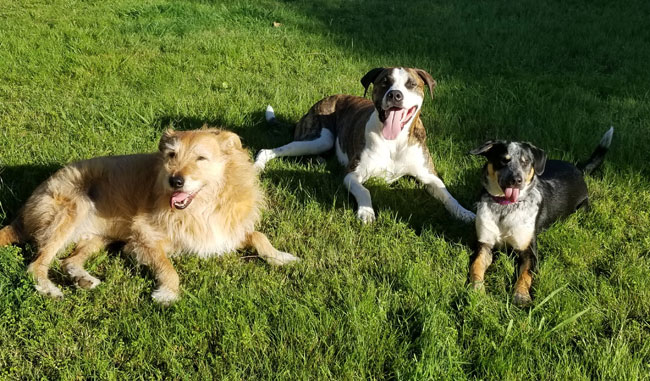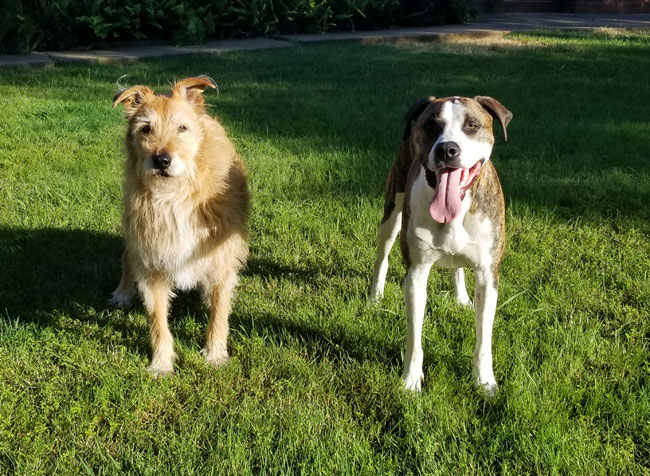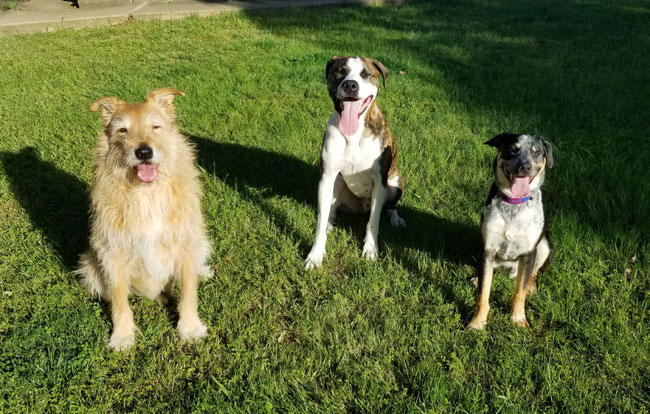My trainer friend Sarah Richardson, owner of The Canine Connection in Chico, California, recently attended a conference in Hot Springs, Arkansas, with a world-renowned pioneer in animal training. She came back home full of inspiration and excitement, with ideas about how she wants to add things and change things in her group training classes.
Sarah hosts a discussion group on Facebook for her training clients, and she posted this shortly after she got back:
“Bob Bailey is now in his 80s but was literally one of the first in the world to be training as we now do with operant conditioning, use of a marker, etc. Bob invited some of the key people he has influenced to serve as his fellow presenters and they came from Canada, Holland, Germany, Mexico, and the US to be with him.
“One of the presenters gave a talk about how ballet improved her dog training. As an adult in her 40s, she took up ballet and learned how hard it is to do the basic movements really well. In contrast, world-class ballerinas practice the basic movements – just the basics – up to 8 hours a day! It got me thinking: How much do we practice the basics – just the basics! – with our dogs so that they are competent with these core skills, and so we are competent with teaching and communicating with our dogs?
“So, I am returning home from my trip with a challenge for myself and my dogs. We are going to return to practicing our canine calisthenics – sit, down, stand – like crazy, in short, frequent training sessions this month. My goal is for my dogs to do these behaviors on a verbal cue as well as on a hand signal and in many different contexts (how they are positioned in relation to me, the setting we are in, etc.).”
Further, Sarah encouraged those in the group to practice and post video of their practice sessions with their dogs.
Time to Start Practicing
I thought I would take the challenge. Back to basics – easy peasy, yes? Both of my dogs know hand and verbal cues for sit, down, and stand, and can readily move from one position to the other. My senior dog Otto is super sharp at these, and eagerly demonstrates his acuity. I looked forward to taking some video of Otto confidently moving through these exercises to share with the discussion group.

I thought (correctly) that I would have to practice more with my younger dog, Woody, before I could commit to putting our efforts on video. Woody takes a more speculative approach to my cues. “Why are you asking?” he seems to say when I give him a cue. He “knows” the cues for sit, down, and stand. After taking a moment to determine whether I’m serious about wanting a response from him, he will methodically change from any one of those positions to any other position. But he tends to get stuck a few position changes into any session of more than three requests. He needs some convincing that the work is worth his while. He may go into a down, and then just stay there after I ask for “sit” or “stand.” His expression seems to say, “I’m just not sure there is a point to all this!”
Food treat rewards increase the motivation – and I don’t blame him one bit. I don’t like working for zero pay, either. And his speed definitely increases when the compensation value increases; he will work longer and faster for chicken or cheese than kibble. But he only gets enthusiastic and sharp-looking if the “pay” is his highest-value reward: a chance to go fetch his Planet Dog Squeak ball.

“What’s In It For Me?”
Woody’s deliberations make me miss my Border Collie, Rupert – the dog I owned when we launched Whole Dog Journal 22 years ago. Well-trained Border Collies make any trainer look good; they love to work and find it incredibly self-rewarding to respond to rapid-fire cues. Many will work without treats or any other tangible reward; the opportunity to work with their person is often enough of a high-value reinforcement in itself! In contrast, Woody, a pit-Lab-mix, has a healthy self-preservation instinct. He wants to know, “What’s in it for me?” before committing himself to a lot of training nonsense.
Otto is somewhere in between. He’s keen to earn my praise and attention, and he likes food treats. But he’s not going to do this all day. I have to keep our practice sessions short and fun, or he starts dramatically sighing and moaning on his “downs” – or looking off to the side when I first give him a cue, like, “Wait, one sec… Did you just hear the mail truck? I think maybe I should go check to see if your mail is here…”
Anyway, I’ve been practicing. I took video on Otto’s first session, and it wasn’t bad. As I predicted, he is really pretty sharp and willing – though the fact that I was holding a camera/phone between us was definitely off-putting to him. And after a dozen or so position changes he was like, “Um, Nance… What’s going on here?”
It took a couple days of practice before I even bothered to try to take some footage of Woody’s efforts. The fact that I recently brought home a nice new Squeak ball helped a lot.
I do tend to take these basic behaviors for granted from my own dogs, but practicing with the goal of taking video that I could share has been fun. It also gives me and my dogs something to “talk about” – an extra few interactions each day that are (I hope) mutually enjoyable. Try it yourself! We’ll put a post on the WDJ Facebook page where you can upload video of your own dogs doing these basic exercises.






Nancy, your post made me smile and then laugh literally out loud when you mentioned your B/C, I have a 12year b/c mix who learns new things so fast and is always there raring to play any game, even though her body isn’t always willing these days. I rescued a hound mix a few years ago and she is and I feel will always be a work in progress, she too looks at the me like I’m crazy, but why wouldn’t we chase the squirrel mum. Some days she’s hyped for some agility and will sit and down, as long as the grass isn’t wet. She’s gone from a crazy wild street hound to a mostly calm house/ranch dog and I love her dearly but she will never be my B/c Peggy Sue. Loved the article, thank you for making me smile today.
I use sit down stand as an exercise to do before we enter the agility ring. It works my dogs muscles and puts their attention on me. When they are puppies and I’m training this sequence the hardest part is “stand.” I hold a nugget treat out near their nose and pull my arm back and up as I say “stand.”
I practiced this today with my golden. Standing was a little challenging from a down. We only used verbal commands today. I plan on practicing this until it’s automatic since my dog and I are about to start making therapy dog visits. Since we will be in a children’s outpatient clinic, I want her to respond to my commands instantly. Thanks for the challenge.
My rat terrier mix, Toby, became deaf as she aged. I was so glad that I had taught her hand signals as well verbal. I was still able to signal behaviors and it made her last few years so much easier as she was still able to understand and do what I asked. No confusion, just a happy girl until the end.
Now I have a service dog who goes everywhere with me. People in my church are amazed that I don’t interrupt their attention to the service by giving verbal commands and they give lots of complements on his behavior. I’ll always teach both to my dogs.
Oh my your article are me laugh out loud. I have rescue like Woody. Anna is my first dog at age 55 and I am learning ALOT. She is a 6 y/o Chinese Shari Pei, Chow Chow,Lab, Boxer, Am Staff……..ok she’s a Mutt but a cute one. But she would prefer to chase anything and everything versus sit, down, stay. Stay….. like right here right now….. with that turkey plucking bugs off your plant….. ummmm no. But seriously she has come so far from the poor untrusting dog who was found tied to a pole with 10 puppies. So off to doggie class we go 😊
Nailed it! We practice these skills all the time as well as Turn(right), Spin(Left), Back, Step (backing one step at a time as I also back one step at a time), I challenge her by doing this at the park, off leash, and from any position….my back turned. However, our efforts has taught me two things about dogs….first of all, these are skills you practice all the time or they lose their edge and you have to be careful not to reward degraded or sloppy behavior if you haven’t done it for a month or so because that will be the new performance response. Also with increased distraction, you have to upgrade the reward to something the dog really values and is willing to work for in the face of everything going on around them. People which don’t know much about dog training think that this is a skill the dog learns and it is permanently part of the dog’s skill set…. much like a human can be taught multiplication tables. I am not sure that is true. That might be true of some dogs but it is not true of any of the dogs I have had. I really loved the way you likened it to calisthentics— as it is a muscle you strengthen all the time. Fail to use it regularly or fail to find new and interesting ways to motivate your dog and the muscle will atrophy and become useless. Maybe you get more consistent responses with certain types of dogs using negative reinforcement or positive punishment but that is a place I am not willing to go, I am very forgiving of my dog but much more demanding of myself. When my dog fails, I evaluate what I am doing wrong (and have always found the solution).
I miss Rupert also. I loved your story about how the farmer who sold you Rupert showed you how he wasn’t interested in sheep.
This article hits the mark with various dogs we’ve had over the years, our new guy “Jax” a race track rescue greyhound will stay and come when called (90%, a work in progress). We work at least 15 minutes daily. When he “stays” he stands………I have never seen him sit and believe it’s uncomfortable for him due to his physique. He would much prefer to lie on his cushion and pretend to sleep whilst watching everything that’s going on.
Your comment about the Greyhound not sitting is very interesting to me. I am a dog trainer (Success Dog Training in Minnesota) with more than 20 years experience. My motto is “We can train any dog” BUT 3 years ago a 6 year old race track rescue Greyhound male was brought to me for training and was not able to get the dog to sit. I asked the owner if he sat at any time at home and she said he really didn’t but would lie down if he wasn’t standing or moving. Finally, since I was able to train him to walk nicely on a loose leash and to reliably come when called, I offered the owner half of her money back and we’d leave it there. She was fine with that arrangement. That was the only Greyhound I ever worked with but what’s with this breed?
After this article I see the value of a Back to the Basics refresher. Thank you.